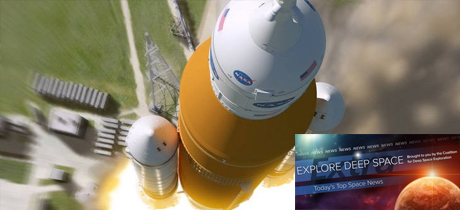In Today’s Deep Space Extra… Though too large and complex for re-use, NASA’s Space Launch System (SLS) has the bi-partisan support of Congress for its role in resuming human deep space exploration. NASA’s long running Kepler planet search mission has drawn to a close, leaving an impressive legacy of discovery.
Human Space Exploration
The Space Review (10/29): NASA’s Space Launch System (SLS), a critical part of plans by the U.S. to resume human deep space exploration with a reusable architecture, is here to stay, writes A.J. Mackenzie, a space policy observer, in an op-ed. If technically challenging, costly and too complex for reuse, the SLS has traversed seven years of development with bi-partisan political support, and any expectation that NASA Administrator Jim Bridenstine would emerge as a vocal opponent dissolved at the Wernher von Braun Memorial Symposium last week. “While SLS may not be reusable, it is important for building that reusable architecture.” said Bridenstine.
Goodbye Europe, hello Moon: European module ships soon
European Space Agency (10/30): The European Space Agency’s (ESA) contribution to NASA’s Orion crew module, a service module with electrical power, life support and chemical propulsion, will ship from Airbus Defense and Space, of Bremen, Germany, to NASA’s Kennedy Space Center (KSC) next week. At Kennedy, the European contribution will be prepared for the first joint test flight of Orion and the Space Launch System (SLS), Exploration Mission-1 (EM-1). The uncrewed test flight around the moon is planned by mid-2020. The service module is based on Europe’s Automated Transfer Vehicle, a resupply capsule that serviced the International Space Station (ISS).
How NASA will use robots to create rocket fuel from Martian soil
IEEE Spectrum (10/30): As part of NASA’s human Deep Space exploration planning, explorers who reach Mars will engage in situ resource utilization, or the recovery of assets like oxygen, water and rocket fuel from the native air and soil. Advanced robotics will play a critical part in the challenging recovery operations.
Space Science
Kepler, the little NASA spacecraft that could, no longer can
New York Times (10/30): Launched in March 2009, NASA’s Kepler space telescope opened the door wide for the discovery of planets beyond the solar system of all varieties. Tuesday, NASA confirmed the spacecraft that trails the Earth around the sun by 94 million miles has exhausted its fuel, as anticipated for weeks and after 2,662 planet discoveries. Launched earlier this year, NASA’s Transiting Exoplanet Survey Satellite (TESS) is already continuing Kepler’s legacy for distant planet discovery.
The planet-hunting Kepler space telescope is dead
Science News (10/30): Its mission now ended after nine and a half years of searching for planets beyond the solar system, NASA’s Kepler space telescope leaves an impressive legacy: Every one of the billions of stars in the Milky Way should have at least one planet.
Hawaiian Supreme Court approves giant telescope on Mauna Kea
New York Times (10/30): Hawaii’s Supreme Court has approved a controversial building permit for the stalled construction of the Thirty Meter Telescope atop the Mauna Kea volcano. The project has encountered opposition over cultural and environmental issues. Its location offers the $2 billion project prime viewing.
Other News
Arianespace soyuz launch schedule unaffected by Russian MS-10 failure
SpaceNews.com (10/30): The European Metop-3 weather satellite is planned to launch as scheduled on November 7 atop a Russian Soyuz launcher despite the October 11 launch abort of a soyuz FG rocket from Kazakhstan with NASA astronaut Nick Hague and cosmonaut Alexey Ovchinin aboard. The two men landed safely and an investigation into the incident is nearing a conclusion. The Metop-3 launch, however, is one of three that will be carried out by a soyuz before men and women assigned to live and work aboard the International Space Station (ISS) climb aboard once again.

